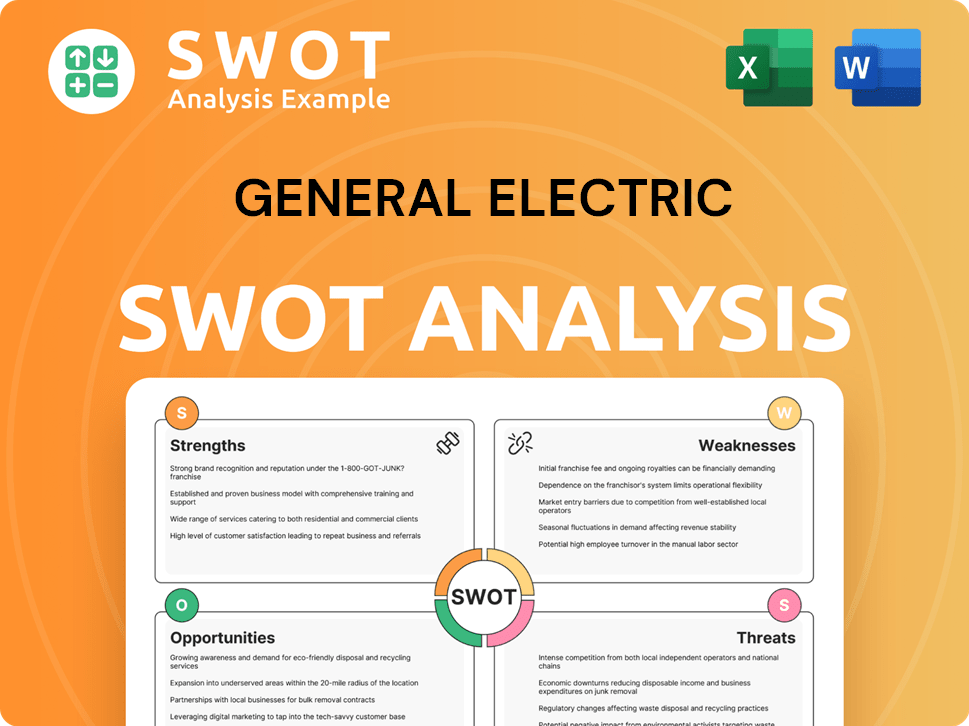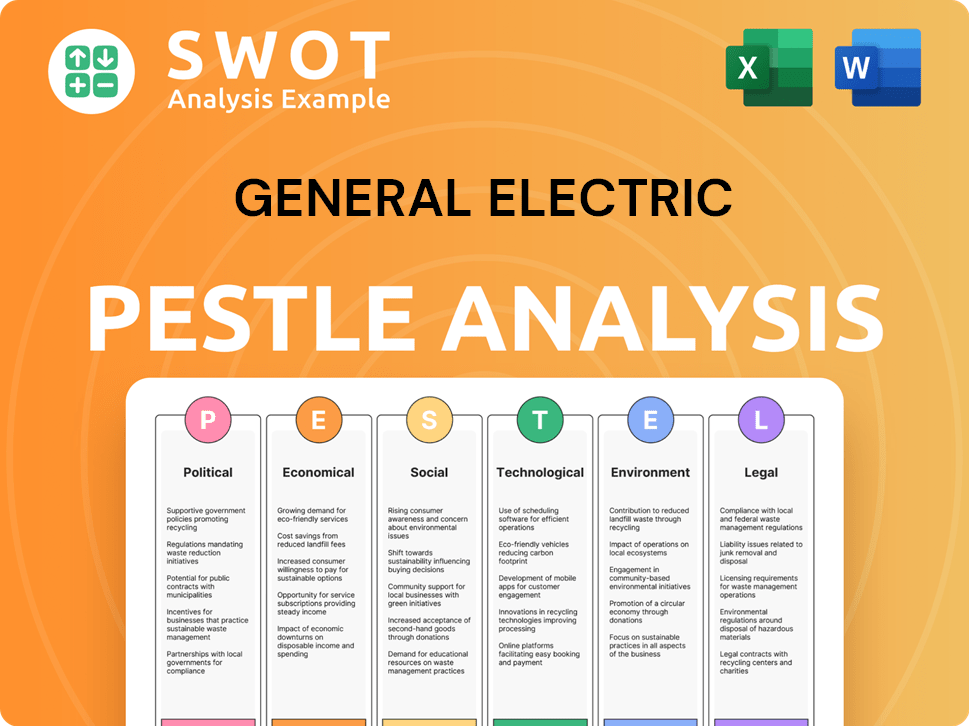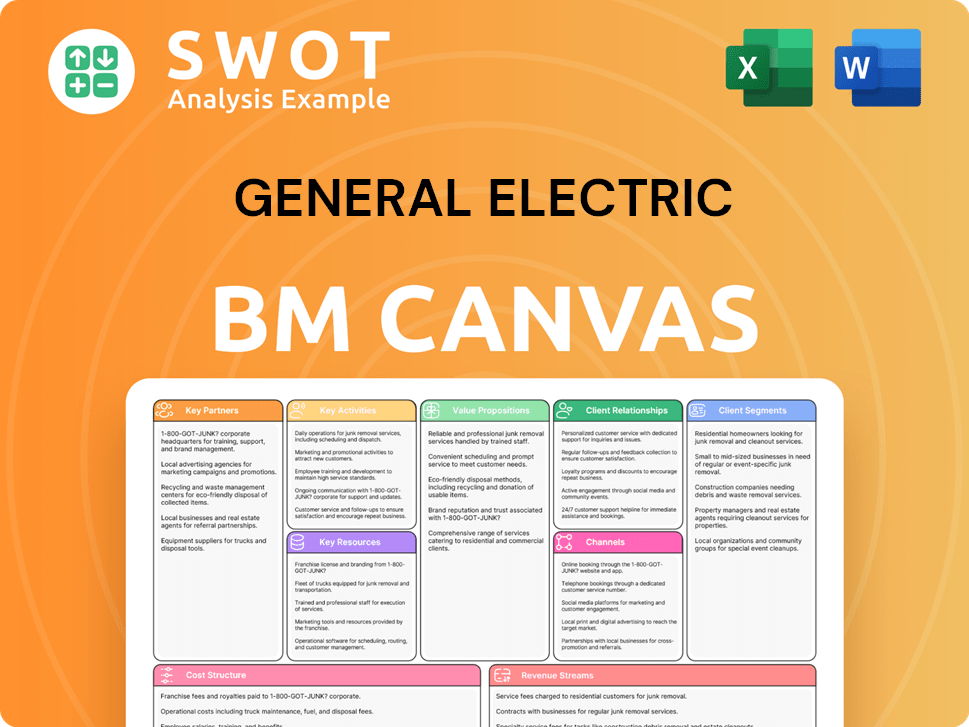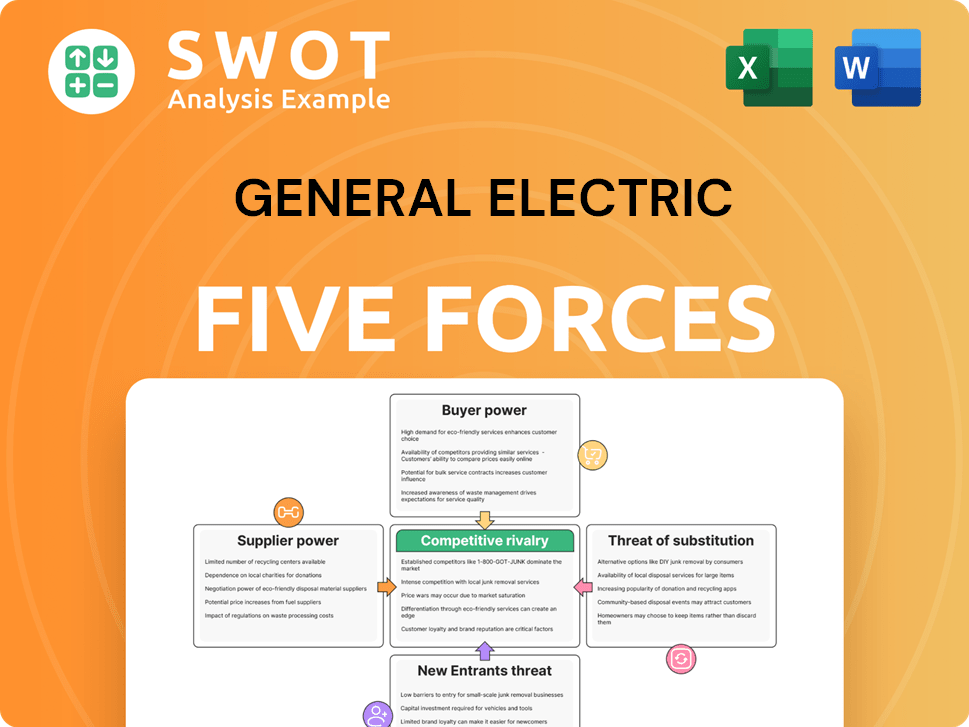General Electric Bundle
How has General Electric's competitive landscape transformed?
General Electric (GE), once a titan of American industry, has dramatically reshaped itself. This evolution, marked by a strategic split into three independent companies, fundamentally altered its competitive positioning. Understanding the new GE landscape is crucial for anyone seeking to navigate the complexities of the modern industrial world.

This General Electric SWOT Analysis delves into the post-split competitive dynamics of GE Aerospace and GE Vernova, examining their key rivals and market strategies. Analyzing the General Electric competitive landscape requires a deep dive into GE competitors and their respective strengths, weaknesses, and strategic focuses, providing a comprehensive view of GE market position. This analysis will equip you with the insights needed to understand how GE is adapting to the changing market and its future outlook.
Where Does General Electric’ Stand in the Current Market?
Following its significant restructuring in early 2024, the competitive landscape of General Electric is primarily defined by its three independent entities: GE Aerospace, GE Vernova, and GE HealthCare. Each company operates in distinct sectors, allowing for a more focused approach to market competition and strategic growth. This restructuring aimed to streamline operations, improve agility, and enhance each entity's ability to compete within its respective industry.
The shift towards independent entities reflects an effort to unlock value and better position each business for long-term success. This strategic move allows each company to tailor its strategies, investments, and partnerships to the specific demands of its market. The restructuring also provides greater transparency for investors, enabling them to assess the performance and potential of each business segment more effectively. The competitive landscape of General Electric has been reshaped to foster innovation and drive operational excellence across its diverse portfolio.
GE Aerospace, GE Vernova, and GE HealthCare each hold unique market positions and face distinct competitive challenges. Understanding the competitive dynamics within each sector is crucial for evaluating the overall performance and future prospects of the new General Electric. The following sections will delve into the specific market positions, competitors, and strategic focuses of each of these three entities.
GE Aerospace holds a dominant position in the aviation industry, particularly in aircraft engines. It is a leading global provider of jet engines for commercial and military aircraft. The company's strong market share is supported by its long-standing relationships with major aircraft manufacturers like Boeing and Airbus. Its geographic presence is global, serving airlines, cargo operators, and military forces worldwide.
The primary competitors for GE Aerospace are Rolls-Royce and Pratt & Whitney (a subsidiary of RTX Corporation). These companies also manufacture jet engines and compete for contracts with aircraft manufacturers and airlines. The competitive landscape is characterized by technological innovation, fuel efficiency, and after-sales service. Revenue Streams & Business Model of General Electric provides more insights into the company's operations.
GE Vernova is a major player in the power generation and renewable energy sectors. It combines GE's legacy power businesses (gas power, steam power, nuclear power) with its renewable energy portfolio (onshore wind, offshore wind, hydro, grid solutions). The company holds a substantial market share in gas turbines globally and is a significant wind turbine manufacturer.
Key competitors for GE Vernova include Siemens, Mitsubishi Heavy Industries, and Vestas. The competitive landscape is driven by the energy transition, with increasing demand for renewable energy solutions. The company faces intense competition and evolving market demands for decarbonization.
GE HealthCare is a global leader in medical technology, pharmaceutical diagnostics, and digital solutions. It holds a strong market position in medical imaging equipment (MRI, CT, ultrasound), patient monitoring systems, and diagnostic pharmaceuticals. The company serves hospitals, clinics, and healthcare providers worldwide.
Main competitors for GE HealthCare include Siemens Healthineers, Philips, and Canon Medical Systems. The competitive landscape is characterized by technological innovation, regulatory compliance, and the need for advanced healthcare solutions. The company consistently ranks among the top companies in its respective segments within the healthcare industry.
The strategic shifts across all three entities reflect a move towards more focused and agile operations, aiming to enhance their competitive standing within their specialized markets. These changes are driven by evolving market dynamics, technological advancements, and the need for sustainable solutions.
- GE Aerospace: Focuses on maintaining and expanding its market share in the aviation industry through innovation and strategic partnerships.
- GE Vernova: Aims to capitalize on the growing demand for renewable energy and sustainable power solutions.
- GE HealthCare: Concentrates on developing and delivering advanced medical technologies and digital solutions to improve patient outcomes.
- Market Analysis: The competitive landscape of General Electric is subject to constant change due to technological advancements, economic trends, and regulatory changes.
General Electric SWOT Analysis
- Complete SWOT Breakdown
- Fully Customizable
- Editable in Excel & Word
- Professional Formatting
- Investor-Ready Format

Who Are the Main Competitors Challenging General Electric?
The Brief History of General Electric reveals a company that has evolved significantly, and its competitive landscape has transformed alongside its restructuring. Following the split into three independent public companies—GE Aerospace, GE Vernova, and GE HealthCare—the competitive dynamics have become more specialized. Each entity now faces a distinct set of rivals, competing within specific industries and market segments.
This strategic shift allows each company to focus on its core competencies and compete more effectively. The competitive landscape is dynamic, with companies constantly innovating and adapting to market changes. Understanding the key competitors and their strategies is crucial for assessing the future prospects of each of the new entities and their ability to maintain or improve their market positions.
The analysis of the General Electric competitive landscape, therefore, requires a segmented approach, examining the rivals of GE Aerospace, GE Vernova, and GE HealthCare individually. This allows for a more detailed and accurate assessment of the competitive pressures and opportunities each company faces.
GE Aerospace's primary competitors are Rolls-Royce and Pratt & Whitney. These companies compete in the aircraft engine market, focusing on fuel efficiency, reliability, and technological innovation. The competition is intense, particularly for contracts with major aircraft manufacturers like Airbus and Boeing.
Rolls-Royce is a major global player in aero engines, particularly strong in widebody aircraft. The company competes directly with GE for contracts and market share. Rolls-Royce's global presence and technological advancements position it as a formidable rival.
Pratt & Whitney, part of RTX Corporation, is another key competitor. Known for its geared turbofan engines, it competes across commercial, military, and business jet segments. The company's technological innovations and market presence make it a strong rival to GE.
GE Vernova faces diverse competition in the power and renewable energy sectors. Key rivals include Siemens Energy, Mitsubishi Heavy Industries, Vestas, Siemens Gamesa Renewable Energy, and Goldwind. These companies compete on turbine efficiency, project development capabilities, and cost-effectiveness.
Siemens Energy is a major competitor in gas turbines and power generation, offering comprehensive power generation and transmission solutions. The company's broad portfolio and global presence make it a significant rival to GE Vernova.
MHI is a significant competitor, particularly in large gas turbines. The company's technological capabilities and market presence pose a challenge to GE Vernova in the power generation sector.
Vestas is one of the largest wind turbine manufacturers globally, competing with GE Vernova in the renewable energy sector. The company's market share and technological advancements make it a key rival.
Siemens Gamesa (a subsidiary of Siemens Energy) is a major player in wind turbines, competing with GE Vernova in the renewable energy market. The company's technology and market position make it a significant competitor.
GE HealthCare's key competitors include Siemens Healthineers, Philips, and Canon Medical Systems. These companies compete in medical imaging, diagnostics, and patient monitoring. The market is also seeing disruption from smaller companies specializing in AI-powered diagnostics.
Siemens Healthineers is a direct and strong competitor across various medical imaging modalities and diagnostics. The company's comprehensive product portfolio and market presence make it a significant rival.
Philips competes in diagnostic imaging, image-guided therapy, and patient monitoring. The company's diverse product offerings and global presence make it a key competitor in the healthcare technology market.
Canon Medical Systems is a significant player in diagnostic imaging equipment. The company's technological advancements and market presence make it a key competitor to GE HealthCare.
The competitive landscape for General Electric is shaped by several factors, including technological innovation, market demand, and economic conditions. The aviation industry, for example, is influenced by fuel efficiency and engine reliability, while the power sector is driven by the transition to renewable energy sources. The healthcare market is experiencing growth in digital health and AI-powered diagnostics. Understanding these trends is critical for assessing the competitive positions of GE's businesses.
- Technological Innovation: Continuous advancements in engine design, renewable energy technologies, and medical imaging are key drivers.
- Market Demand: Demand for more efficient engines, sustainable energy solutions, and advanced healthcare technologies shapes the competitive landscape.
- Economic Conditions: Global economic trends, including inflation and interest rates, impact investment and spending in these industries.
- Regulatory Environment: Government regulations and policies influence market access and competition.
- Strategic Alliances: Partnerships and collaborations can provide competitive advantages, such as access to new technologies or markets.
General Electric PESTLE Analysis
- Covers All 6 PESTLE Categories
- No Research Needed – Save Hours of Work
- Built by Experts, Trusted by Consultants
- Instant Download, Ready to Use
- 100% Editable, Fully Customizable

What Gives General Electric a Competitive Edge Over Its Rivals?
Understanding the competitive landscape of General Electric (GE) involves examining its diverse business segments: GE Aerospace, GE Vernova, and GE HealthCare. Each segment has unique competitive advantages, shaped by its industry dynamics, technological advancements, and strategic positioning. This analysis is crucial for investors, analysts, and business strategists to assess GE's market position and future prospects. In the dynamic industries GE operates in, understanding its strengths and weaknesses is essential for making informed decisions.
GE's competitive advantages are not static; they evolve with market trends and technological shifts. For instance, the company's focus on sustainable energy solutions and digital healthcare technologies reflects its adaptation to changing market demands. A detailed look into GE's competitive strengths provides insights into its ability to maintain and grow its market share. This involves analyzing its financial performance, innovation capabilities, and strategic partnerships to understand its overall competitive edge.
The company's approach to innovation, strategic alliances, and financial management plays a significant role in its competitive standing. For example, GE's R&D spending and its ability to form strategic partnerships are critical for maintaining a competitive edge. The competitive landscape of GE is influenced by factors such as technological advancements, economic trends, and regulatory changes. A comprehensive analysis will help stakeholders understand GE's position in the market.
GE Aerospace benefits from its extensive experience in aircraft engine design and manufacturing. Its proprietary technologies, including advanced materials and aerodynamic designs, contribute to superior fuel efficiency. The company's brand equity, built over decades of reliable performance, is a significant asset in securing new contracts and maintaining customer relationships. The long product life cycles of aircraft engines create high barriers to entry.
GE Vernova's competitive advantages stem from its comprehensive portfolio of power generation solutions, spanning traditional thermal power to renewable energy technologies. Its legacy in gas turbine technology provides a strong foundation, with a large installed base globally that requires ongoing service and upgrades. The company benefits from its ability to offer integrated solutions for power generation, transmission, and grid modernization. Its global service capabilities and strong customer relationships are key differentiators.
GE HealthCare's competitive strengths include its strong brand recognition and a broad portfolio of advanced medical imaging equipment, diagnostic pharmaceuticals, and digital solutions. The company's significant investment in research and development allows it to bring innovative products to market, such as AI-powered diagnostic tools. Its established relationships with hospitals and healthcare providers worldwide contribute to strong customer loyalty. Regulatory expertise is also a critical advantage.
GE is adapting to changing market dynamics by focusing on sustainable energy and digital healthcare. This strategic shift involves significant investments in R&D and strategic partnerships. The company's ability to innovate and respond to market needs is crucial for maintaining its competitive position. The company's strategy is supported by its financial performance and its ability to navigate complex global markets.
GE's competitive advantages are rooted in its technological expertise, global presence, and strong customer relationships. The company's ability to innovate and adapt to market changes is critical. Understanding the competitive landscape of General Electric requires a deep dive into each business segment.
- Technological Innovation: GE invests heavily in R&D, particularly in areas like aircraft engines, renewable energy, and medical imaging. This leads to the development of advanced products and services.
- Global Presence: GE operates worldwide, providing it with access to diverse markets and customer bases. This global reach allows for economies of scale and diversified revenue streams.
- Strong Customer Relationships: GE has built strong relationships with customers in various sectors, including airlines, utilities, and healthcare providers. These relationships foster loyalty and recurring revenue through service contracts.
- Brand Recognition: The company's brand equity, built over decades, is a significant asset. It enhances customer trust and facilitates new business opportunities.
- Strategic Partnerships: GE forms strategic alliances to enhance its market position and access new technologies. These partnerships help drive innovation and expand market reach. For example, GE has collaborated with various technology firms to develop AI-powered diagnostic tools.
General Electric Business Model Canvas
- Complete 9-Block Business Model Canvas
- Effortlessly Communicate Your Business Strategy
- Investor-Ready BMC Format
- 100% Editable and Customizable
- Clear and Structured Layout

What Industry Trends Are Reshaping General Electric’s Competitive Landscape?
The competitive landscape for General Electric (GE) is shaped by its diverse portfolio across aerospace, energy, and healthcare. The company faces distinct challenges and opportunities within each sector, influenced by industry trends and market dynamics. Understanding the evolving market positions and strategic adaptations of GE is crucial for assessing its long-term performance and investment potential. A comprehensive Growth Strategy of General Electric analysis provides deeper insights into its competitive environment.
GE's ability to navigate these trends and challenges will determine its future success. The company's strategic focus on innovation, operational efficiency, and strategic partnerships is vital. It is important to look at the competitive landscape, the primary keywords, and the long-tail keywords to have a better understanding.
GE Aerospace is significantly impacted by the aviation industry's move towards sustainability. The demand for more fuel-efficient engines and sustainable aviation fuel (SAF) is on the rise. Challenges include developing new propulsion technologies and managing supply chain disruptions. Opportunities include the recovery in air travel and the growing defense budgets.
GE Vernova is at the forefront of the global energy transition. Key trends include the shift to renewable energy and grid modernization. Challenges involve competition and the intermittency of renewable sources. The opportunity lies in integrated energy solutions and the global push for decarbonization.
GE HealthCare faces trends such as the increasing demand for healthcare services and the rise of chronic diseases. Challenges include regulatory complexities and cybersecurity threats. Opportunities arise in emerging markets and the development of AI-driven diagnostic tools.
The strategic separations allow each entity to focus on its specific industry trends and tailor its strategies more effectively to remain resilient and competitive. Each business can better address its unique market dynamics and competitive pressures. This focused approach is designed to drive innovation and enhance value creation.
Recent financial data and market analysis highlight the competitive positioning of GE's business segments. These figures underscore the company's performance in key markets, its response to industry trends, and its strategic initiatives. Data from 2024 and early 2025 will be critical for assessing the impact of these strategic shifts.
- GE Aerospace: In 2024, the commercial engines and services segment saw a strong recovery, with revenue growth driven by increased air travel and demand for engine maintenance. The defense segment also showed growth, supported by higher military spending.
- GE Vernova: The renewable energy sector experienced fluctuating demand and intense competition, with GE Vernova focusing on grid solutions and energy storage. Investments in offshore wind projects and grid modernization are key for future growth.
- GE HealthCare: The healthcare segment continued to grow, driven by demand for advanced medical imaging and diagnostic equipment. The focus remains on expanding into emerging markets and developing AI-driven diagnostic tools.
- Market Share: GE holds a significant market share in the aviation engine market, competing with companies like Rolls-Royce and Pratt & Whitney. In the power generation sector, GE competes with Siemens and Mitsubishi Power. In healthcare, it rivals Siemens Healthineers and Philips.
- R&D Spending: GE invests heavily in research and development, with a focus on sustainable aviation technologies, advanced grid solutions, and AI-driven healthcare innovations.
General Electric Porter's Five Forces Analysis
- Covers All 5 Competitive Forces in Detail
- Structured for Consultants, Students, and Founders
- 100% Editable in Microsoft Word & Excel
- Instant Digital Download – Use Immediately
- Compatible with Mac & PC – Fully Unlocked

Related Blogs
- What are Mission Vision & Core Values of General Electric Company?
- What is Growth Strategy and Future Prospects of General Electric Company?
- How Does General Electric Company Work?
- What is Sales and Marketing Strategy of General Electric Company?
- What is Brief History of General Electric Company?
- Who Owns General Electric Company?
- What is Customer Demographics and Target Market of General Electric Company?
Disclaimer
All information, articles, and product details provided on this website are for general informational and educational purposes only. We do not claim any ownership over, nor do we intend to infringe upon, any trademarks, copyrights, logos, brand names, or other intellectual property mentioned or depicted on this site. Such intellectual property remains the property of its respective owners, and any references here are made solely for identification or informational purposes, without implying any affiliation, endorsement, or partnership.
We make no representations or warranties, express or implied, regarding the accuracy, completeness, or suitability of any content or products presented. Nothing on this website should be construed as legal, tax, investment, financial, medical, or other professional advice. In addition, no part of this site—including articles or product references—constitutes a solicitation, recommendation, endorsement, advertisement, or offer to buy or sell any securities, franchises, or other financial instruments, particularly in jurisdictions where such activity would be unlawful.
All content is of a general nature and may not address the specific circumstances of any individual or entity. It is not a substitute for professional advice or services. Any actions you take based on the information provided here are strictly at your own risk. You accept full responsibility for any decisions or outcomes arising from your use of this website and agree to release us from any liability in connection with your use of, or reliance upon, the content or products found herein.